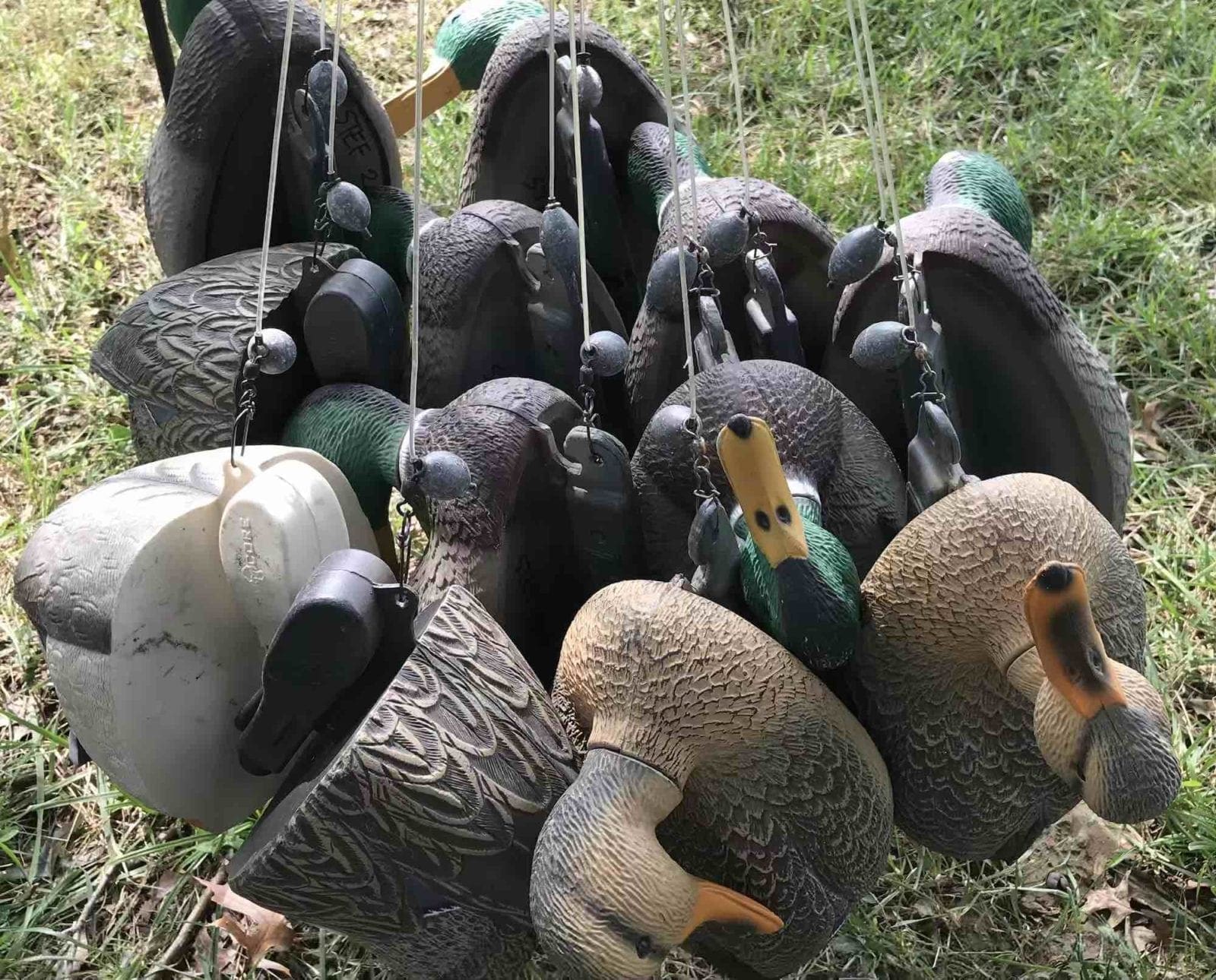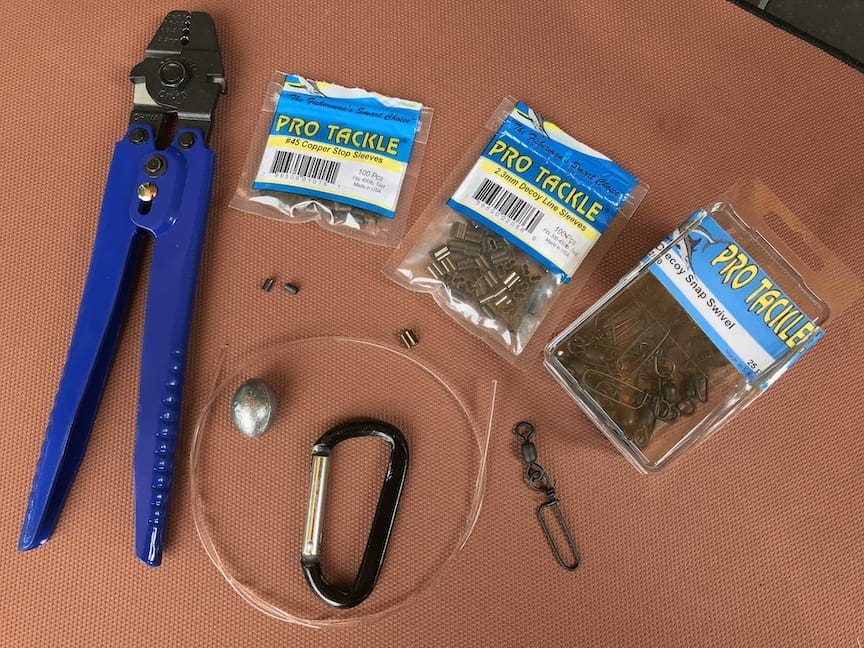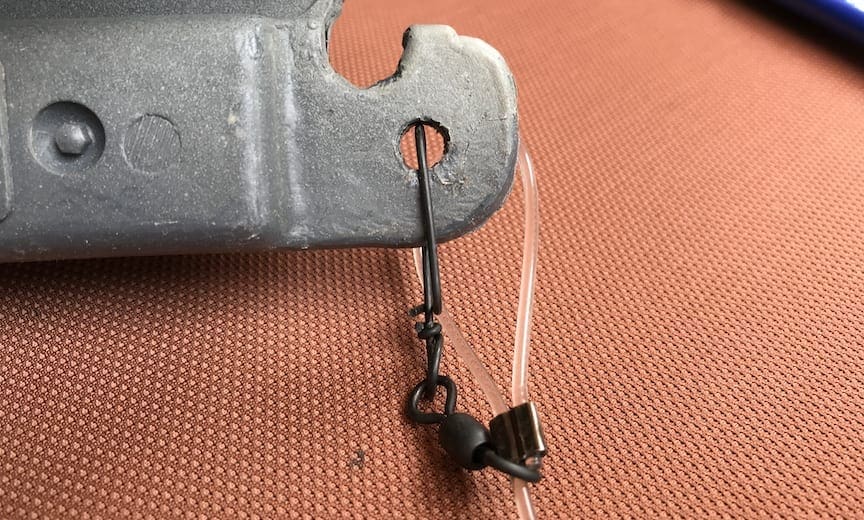Home » Waterfowl Hunting » How to Make Custom Texas Rig Decoy Anchors
How to Make Custom Texas Rig Decoy Anchors

Brad Stefanoni grew up hunting quail and waterfowl in southeast…
Do-it-yourself instructions for making these convenient decoy anchor setups
The older I get, the more often I can be heard preaching at my hunting pals to “work smarter not harder.” About seven or eight years ago I took my own advice and switched my entire floating duck decoy spread from traditional twine and lead strap anchors to Texas rigged anchors. Let me tell you…It’s. A. Game. Changer!
Texas rig decoy anchors were born on the Gulf Coast of Texas and Louisiana. They utilize heavy (400+ pound test) monofilament line with a loop on one end and an egg-shaped lead weight affixed to the opposite end. The monofilament line is rigged in such a way that it slides freely through the hole in a large snap swivel attached to the decoy’s keel. The end loop allows for several decoys to be attached together with a spring clip (a.k.a. “carabiner”). A dozen or more decoys can be easily picked up and moved to a different spot or to a vehicle for the ride back to duck camp. Best of all, Texas rigs are resistant to tangling; after all, who wants to untangle five dozen decoys when the greenheads are circling your favorite duck hole?
Many companies offer pre-rigged Texas rig anchor sets in lengths ranging from 18-inches up to 5-feet and longer. I first dipped my toe into the water of Texas rig anchors by purchasing a set of one dozen anchors with 3-foot long lines and 4 ounce weights. After the first hunt I was hooked. I began thinking about how I would want to tweak the system to better suit my specific needs.
A couple of years ago my D.I.Y. tendencies got the best of me and I decided to make a batch of my own custom Texas rig anchors from scratch. For the shallow marsh area where I hunt, I wanted very short anchor lines of 24-inches or less. I also wanted lighter-weight anchors of 2 ounces because, let’s face it, I’m not getting any younger. With the abundance of moist soil vegetation and shallow water at my hunting spot I don’t have to worry about my decoys going for a joy ride on windy days.
The ingredients for making Texas rig decoy anchors
When I embark on a D.I.Y. project like this the first thing I look for is a materials list. Here are the ingredients you’ll need to bake your own batch of D.I.Y. Texas rig anchors:

- 400 lb. test clear monofilament line (can be purchased in pre-cut lengths or rolls)
- 325-yard roll: $17.50 per roll
- Pre-cut 48-inch monofilament line pack (200 lines per pack): $12.50
- Egg-shaped slip sinker anchors (sizes range from two to eight ounces)
- 2 oz: $0.46 each
- 3 oz: $0.69 each
- 4 oz: $0.92 each
- 5 oz: $1.15 each
- 6 oz: $1.38 each
- 8 oz: $1.84 each
- Stop sleeves to secure the anchors to the line (0.23-inches long/2.3mm inside diameter)
- Pack of 100: $3.65 per pack
- Decoy line sleeves to create the loop at the opposite end of the decoys (2.3 mm inside diameter)
- Pack of 100: $3.90 per pack
- Pack of 1,000: $35.00 per pack
- 2/0 decoy snap swivels
- Pack of 25: $9.95 per pack
- Pack of 100: $36.90
- Hand crimping tool, electrical crimping tool, or pliers (investing in a specially made hand crimping tool will make your life easier and may prevent a stream of “fowl” language flowing out of your mouth)
- Hand crimping tool: $27.85 each
- Electrical crimping tool: $15.97
- Pliers: $3.49
- Wire cutters or pocket knife for finish trimming
- Spring clips (a.k.a. “carabiner”); one for every 12-18 decoys: $0.85 each
The recipe for Texas rig decoy anchors
Making your own Texas rig anchors is an activity that can involve the whole family, so create an assembly line at the workbench for an afternoon with the fam. In keeping with the theme of working smarter not harder, here are 6 simple steps:
- First, cut your clear monofilament line to your desired anchor line length. Add three inches to your overall length to account for creating the loop at the end. For example, if you want 36″ anchor lines, cut your line to 39″.
- Next, add the decoy line sleeve by sliding the line in through one channel and back through the other channel to make the loop at the end. Make your loop big enough to insert a finger through with some wiggle-room. Use your crimping tool to secure the decoy line sleeve by pinching together both sides of the sleeve. Be careful to not squeeze it too tightly or you could cut the line with the line sleeve.
- THIS STEP IS VERY IMPORTANT! From the opposite, unfinished end of your line segment, slip on one 2/0 decoy snap swivel by sliding the line through the round closed loop on one end of the snap swivel.
- Next, slip on one stop sleeve, then slide on your egg slip sinker. Finally, slip on the second stop sleeve. You’ll end up essentially book-ending your sinker with stop sleeves.
- Use your crimping tool to secure both stop sleeves firmly to the line.
- Open the snap swivel and attach your anchor line to the hole in your decoy’s keel. The line should slide through the snap swivel loop freely.


Where to purchase D.I.Y. supplies
Most of the supplies needed for custom Texas rig decoys can be purchased at a local sporting goods retailer and a hardware store. Many online retailers are also great sources for purchasing basic materials.
If you’re serious about taking on this project for your decoy spread I recommend you visit the SNL Corporation website as I’ve found them to be my one-stop shop for all things Texas rigging. The “Duck Decoy Rigging” section of their website is dedicated solely to supplying folks with everything needed for D.I.Y. Texas rigging.
Supplies to keep on hand for repairs
Anchors will inevitably slip off lines and fall into the muddy abyss of the marsh. Snap swivels will get caught on your blind and break off. If you’re a klutz like me, you’ll even step on a few of your anchor lines and murmur expletives under your breath. Gear breaks; get used to it and plan for it.
Following are a few items I always keep in my duck hunting backpack to make repairs in the field to my Texas-rigged decoys:
- A half-dozen pre-cut monofilament anchor lines
- A half-dozen egg sinkers
- An small travel pill case with a few extra stop sleeves, snap swivels, and line sleeves
- A multi-tool that is equipped with a small pair of pliers and knife blade
Cost comparison: pre-rigged vs. D.I.Y.
Okay, how much is this going to cost?
Pre-rigged
A 12-pack of pre-made 36-inch long/4 ounce Texas rig decoy anchors starts around $24.00 per 12-pack and goes up from there depending on brand, length of anchor lines etc. Bargain-minded D.I.Yers can often find inventory-clearing sales during the off-season for as low as $19.99. Most online waterfowl retailers carry these pre-made anchor packs.
D.I.Y.
Using the costs outlined in the ingredients section above, here’s my math:
- Monofilament line: $0.05 each
- 3 ounce slip sinker: $0.69 each
- Stop sleeves: $0.04 each
- Line sleeves: $0.04 each
- 2/0 decoy snap swivels: $0.40 each
- Spring clip: $0.85 each (one spring clip per 12-18 decoys)
- TOTAL per dozen decoy anchors including one spring clip: $15.49 (does not include price of crimping tools or pliers)
In our world of battery-powered wing spinners and wave-making duck butts, I think anyone can appreciate the simplicity that Texas rigs bring to a duck decoy set. They’re easy to make, relatively inexpensive, and save time deploying decoys before the hunt and retrieving them afterwards. Who doesn’t want to spend more time working groups of mallards and less time fighting with decoy anchor lines?
Brad Stefanoni grew up hunting quail and waterfowl in southeast Kansas, where for the past 20 years he’s been passing on what he learned to his wife and their two sons. His diverse background includes work as a biologist, a science education center director, an outdoor writer and a developer of public/private partnerships. With a degree in wildlife biology, Brad’s current work-in-progress is transforming his family’s 80-acre farm into a living laboratory of upland and wetland habitat. His passions include spending time with his family and black Labrador retriever pursuing waterfowl and upland birds, and fly fishing.



